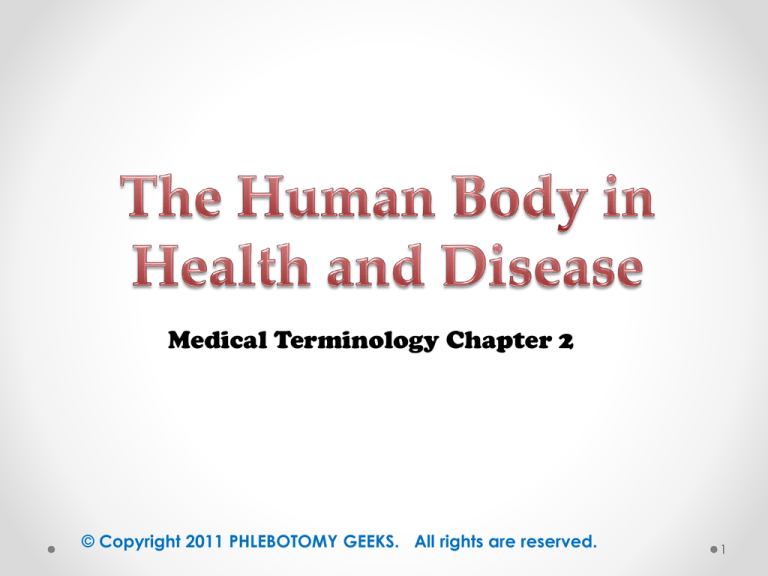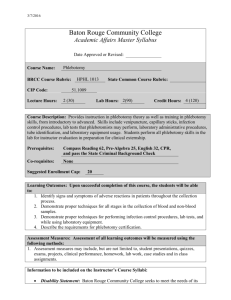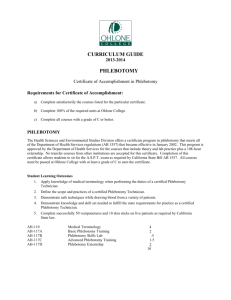
Medical Terminology Chapter 2
© Copyright 2011 PHLEBOTOMY GEEKS. All rights are reserved.
1
© Copyright 2011 PHLEBOTOMY
GEEKS. All rights are reserved.
2
• Define anatomy and physiology, and the uses of
anatomical reference systems to identify the anatomical
position plus body planes, directions and cavities
• Recognize, define, spell and pronounce the primary
terms related to cells and genetics
• Recognize, define, spell, and pronounce the primary
terms related to the structure, function, pathology, and
procedures of tissues and glands
• Identify the major organs and functions of the body
systems
• Recognize, define, spell, and pronounce the primary
terms used to describe pathology, the modes of
transmission, and the types of diseases
© Copyright 2011 PHLEBOTOMY GEEKS. All rights are reserved.
• Anatomic reference systems: Used to describe the
location of body planes, directions, and cavities
• Structures of the body: The cells, tissues and glands that
form the body systems which work together to allow the
body to function properly
• Genetics: the genetic components that transfer
characteristics from parents to their children
• Tissues: a group of similarly specialized cells that work
together to perform specific functions
• Glands: a group of specialized cells capable of
producing secretions
• Body systems and related organs: organs are somewhat
independent body parts that perform certain functions.
Organs with related functions are organized into body
systems.
• Pathology: the study of the nature and cause of disease
that involve changes in structure and function
© Copyright 2011 PHLEBOTOMY GEEKS. All rights are reserved.
4
adeno/o: gland
adip/o: fat
anter/o: before, front
caud/o: lower part of body, tail
cephal/o: head
© Copyright 2011 PHLEBOTOMY GEEKS. All rights are reserved.
5
cyt/o, –cyte: cell
end–, endo– : in, within, inside
exo– : out of, outside, away from
hist/o, histi/o: tissue
path/o, -pathy: disease, suffering, feeling, emotion
poster/o: behind, toward the back
© Copyright 2011 PHLEBOTOMY GEEKS. All rights are reserved.
6
Anatomy & Physiology
• Anatomy is the study of the structures of the body
• Physiology is the study of the functions of the
structures of the body
7
Describes the body standing in the
standard position:
standing up straight so that the body is erect
and facing forward
holding the arms that the sides of the hands
turned for the palms face toward the front
© Copyright 2011 PHLEBOTOMY GEEKS. All rights are reserved.
8
Imaginary vertical and horizontal lines used to divide
the body into sections for descriptive purposes
9
• Sagittal Plane: vertical plane that divides
the body into unequal left and right
portions
• Mid-Sagittal Plane: (also known as the
midline) the sagittal plane that divides to
the body into equal left and right halves
• Frontal Plane: a vertical plane that
divides the body into front (anterior) and
back (posterior) portions
© Copyright 2011 PHLEBOTOMY GEEKS. All rights are reserved.
10
a flat crosswise plane, such as the horizon
• Transverse Plane: a horizontal plane that divide the body into upper (superior)
go after lower (inferior) and lower portions
• Can be at the waist or at any other level across the body
© Copyright 2011 PHLEBOTOMY GEEKS. All rights are reserved.
11
•
•
•
•
•
•
•
•
•
•
•
•
Ventral: refers to the front or belly side of the organ or body
Dorsal: refers to the back of the organ or body
Anterior: situated in the front, or on the front or forward part of an
organ
Posterior: or on the back part of an organ
Superior: uppermost, above, or toward the head
Inferior: lowermost, below or toward the feet
Cephalic: toward the head
Caudal: toward the lower part of the body
Proximal: situated nearest the midline or beginning of a body
structure
Distal: situated farthest from the midline or beginning of a body
structure
Medial: the direction toward, or nearer, the midline
Lateral: the direction toward or near the side of the body, away
from the midline
© Copyright 2011 PHLEBOTOMY GEEKS. All rights are reserved.
12
Spaces within the body that contain
and protect internal organs
the 2 major •dorsal (back)
body
cavities are: •ventral (front)
© Copyright 2011 PHLEBOTOMY GEEKS. All rights are reserved.
13
• Located along the back of the body and head
• contains organs of the nervous system that
coordinate body function
Divided into 2 portions:
• the cranial cavity (located within the skull, surrounds
and protects the brain)
• the spinal cavity (located within the spinal column,
surrounds and protects the spinal cord)
© Copyright 2011 PHLEBOTOMY GEEKS. All rights are reserved.
14
Located along the front of the
body
contains the body organs that
sustain homeostasis (the
processes through which the
body maintains a constant
internal environment)
© Copyright 2011 PHLEBOTOMY GEEKS. All rights are reserved.
15
Thoracic Cavity: (chest cavity, thorax) surrounds and
protects the heart and lungs
Abdominal Cavity: contains the major organs of digestion
(frequently referred to as the abdomen)
Pelvic Cavity: the space formed by the hipbones
contains the organs of the reproductive and excretory
systems
Abdominopelvic Cavity: refers to be abdominal and pelvic
cavities as a single unit
Inguinal: (relating to the groin) refers to the entire lower
area of the abdomen
© Copyright 2011 PHLEBOTOMY GEEKS. All rights are reserved.
16
© Copyright 2011 PHLEBOTOMY GEEKS. All rights are reserved.
17
Regions of the Thorax and
Abdomen
Descriptive system that divides the abdomen and
lower portion of the thorax into nine sections
© Copyright 2011 PHLEBOTOMY GEEKS. All rights are reserved.
18
• Right and Left Hypochondriac Regions: covered by
the lower ribs
• Epigastric Region: located above the stomach
• Right and Left Lumbar Regions: located near the
inward curve of the spine
• Umbilical Region: pit in the center of the abdominal
wall that marks the point where the umbilical cord
was attached before birth
• Right and Left Iliac Regions: located over the
hipbones
• Hypogastric Region: located below the stomach
© Copyright 2011 PHLEBOTOMY GEEKS. All rights are reserved.
19
Division of the abdomen into for imaginary quadrants,
making it easier to describe when abdominal organ or
pain is located
• (RUQ) right upper quadrant
• (LUQ) left upper quadrant
• (RLQ) right lower quadrant
• (LLQ) left lower quadrant
© Copyright 2011 PHLEBOTOMY GEEKS. All rights are reserved.
20
© Copyright 2011 PHLEBOTOMY GEEKS. All rights are reserved.
21
22
23
Structural Organization of the Human Body
• Cells: the basic structural and functional units of the
body
• cells are specialized and grouped together to form
tissues and organs
• Cell Membrane: the tissue that surrounds and
protects the contents of the cell by separating
them from its external environment
• Cytoplasm: the material within the cell membrane
that is not part of the nucleus
• Nucleus: a structure within the cell, which is
surrounded by the nuclear membrane. It controls
the activities of the cell and helps the cell divide
© Copyright 2011 PHLEBOTOMY GEEKS. All rights are reserved.
24
25
26
• Dominant: When inherited from either parent, the
child will inherit that genetic condition or
characteristic
• Recessive: When inherited from both parents, the
child will have that condition. One inherited from
only one parent, and a normal gene is then
inherited from the other parent, the child will not
have the condition. However, in this instance, the
child will carry the trait for that condition (this means
that their child/ren could have the condition,
depending on the ges inherited from the other
parent)
© Copyright 2011 PHLEBOTOMY GEEKS. All rights are reserved.
27
Genetic structures located within the nucleus of each
cell
• made up of the DNA molecules containing the
body's genes
• somatic cells contain 46 chromosomes arranged
into 23 pairs
• 22 identical pairs of chromosomes, and the
remaining pair:
• XX (female)
• XY (male)
X or Y chromosome from father determines sex of the
child
© Copyright 2011 PHLEBOTOMY GEEKS. All rights are reserved.
28
• Basic structure of the DNA molecule, which is
located on the pairs of chromosomes in the nucleus
of each cell, contains thousands of genes that
provide the information essential for heredity,
determining physical appearance, disease risks,
and other traits
• found in the nucleus of all types of cells except the
red blood cells (because erythrocytes do not have
a nucleus)
• no 2 DNA patterns are exactly the same (except for
identical twins)
© Copyright 2011 PHLEBOTOMY GEEKS. All rights are reserved.
29
• A pathological condition caused by an absent or
defective gene
• some are obvious at birth
• others may manifest at any time in life
• cystic fibrosis: present at birth and affects the respiratory
and digestive systems
• down syndrome: associated with a characteristic facial
appearance, learning disabilities, and various physical
abnormalities
• hemophilia: hereditary bleeding disorders in which a
blood clotting factor is missing (characterized by
spontaneous hemorrhages or severe bleeding following
an injury)
© Copyright 2011 PHLEBOTOMY GEEKS. All rights are reserved.
30
GENETIC DISORDERS
• muscular dystrophy: group of diseases characterized by
progressive weakness and degeneration of the skeletal
muscles that control movement
• PKU: the essential digestive enzyme, phenylalanine
hydroxylase is missing (can be detected at birth and
with careful dietary supervision, these children can lead
normal lives) without early detection and treatment, PKU
causes severe mental retardation
• Tay-Sachs disease: fatal disorder in which harmful
quantities of a fatty substance buildup in tissues and
nerve cells in the brain (commonly, these babies appear
healthy at birth and appear to develop normally for the
first few months, then development swells in a relentless
deterioration of mental and physical abilities, results in
progressive blindness, paralysis, and early death
© Copyright 2011 PHLEBOTOMY GEEKS. All rights are reserved.
31
A group or layer of similarly specialized cells that join
together to perform certain specific functions
32
4 main types of tissue
1. Epithelial tissue - (form a protective covering for all
of the internal and external surfaces of the body)
• epithelium - (forms the epidermis of the skin and the
surface layer of mucous membranes)
• Endothelium - (lines the blood and lymph vessels,
body cavities, glands, and organ)
2. Connective tissue - (Support and connect organs
and other body tissues)
3. Muscle tissue - Contains cells with the specialized
ability to contract and relax
4. Nerve tissue - Contains cells with the specialized
ability to react to stimuli and to conduct electrical
impulses
© Copyright 2011 PHLEBOTOMY GEEKS. All rights are reserved.
33
34
• Dense connective tissue - (bone and cartilage)
form joints and framework of the body
• Adipose tissue - (fat) provide protective padding,
insulation and support
• Loose connective tissue - (blood and lymph)
transport nutrients it waste products throughout the
body
© Copyright 2011 PHLEBOTOMY GEEKS. All rights are reserved.
35
36
© Copyright 2011 PHLEBOTOMY GEEKS. All rights are reserved.
37
38
39
A group of specialized epithelial cells that are
capable of producing secretions
the 2 major types of glands:
• EXOCRINE GLANDS- secrete chemical substances
and to ducks that lead either to organs or out of the
body (sweat glands)
• ENDOCRINE GLANDS - produce hormones and
have no ducts (hormones are secreted directly into
the bloodstream and then transported to organs
and structures throughout the body)
© Copyright 2011 PHLEBOTOMY GEEKS. All rights are reserved.
40
aden/o = gland
-itis = inflammation
carcin = cancerous
-oma = tumor
malignant = harmful, capable of spreading, and
potentially life-threatening
• benign = not life-threatening
• -malacia = abnormal softening
•
•
•
•
•
© Copyright 2011 PHLEBOTOMY GEEKS. All rights are reserved.
41
DISEASE TRANSMISSION
• Pathogen - a disease producing microorganism
• transmission - the spread of a disease
• contamination - a pathogen and possibly present
(occurs through of proper hygiene standards or by
failure to take appropriate infection control measures)
• communicable disease - (contagious disease) any
condition that is transmitted from one person to another,
either by direct or indirect contact with contaminated
objects (communicable - capable of being transmitted)
• indirect contact transmission - situation in which a
susceptible person is infected by contact with a
contaminated surface
© Copyright 2011 PHLEBOTOMY GEEKS. All rights are reserved.
42
• blood-borne transmission - spread of disease through
contact with blood or other body fluids that are
contaminated with blood (HIV, hepatitis B, and most
STDs)
• airborne transmission - occurs through contact with
contaminated respiratory droplet spread by a cough or
sneeze (tuberculosis, flu, colds, and measles)
• food-borne and waterborne transmission (fecal-oral
transmission) - caused by eating or drinking
contaminated food or water that is not been properly
treated to remove contamination or kill pathogens
present
• vector-borne transmission - the spread of disease due to
the bite of a vector (insects or animals such as
mosquitoes, flies, mites, fleas, ticks, rats, and dogs)
© Copyright 2011 PHLEBOTOMY GEEKS. All rights are reserved.
43
• Endemic: The ongoing presence of a
disease within a population, group, or
area
• Epidemic: A sudden and widespread
outbreak of a disease within a specific
population, group, or area
© Copyright 2011 PHLEBOTOMY GEEKS. All rights are reserved.
44
BODY SYSTEM
MAJOR STRUCTURES
MAJOR FUNCTIONS
Skeletal
Bones, joints, and
cartilage
Supports and shapes the
body. Protects the
internal organs. Forms
some blood cells in
stores minerals.
Muscular
Muscle, fascia, and
tendons
Holds the body erect.
Makes movement
possible. Moves body
fluids and generates
body heat.
Cardiovascular
Heart, arteries, veins,
capillaries, and blood
Blood circulates through
the body to transport
oxygen and nutrients to
the cells and to carry
waste products to the
kidneys for removal by
filtration
45
BODY SYSTEM
MAJOR STRUCTURES
MAJOR FUNCTIONS
Lymphatic
Lymph, lymphatic
vessels, and lymph nodes
Removes and transports
waste products from the
fluid between the cells.
Destroys harmful
substances (pathogens in
cancer cells) in the
lymph nodes. Returns
the filter ltymph to the
bloodstream where
becomes plasma again
Immune
Tonsils, spleen, thymus,
skin and specialized
blood cells
Defends and protects the
body against invading
pathogens and allergens
Respiratory
Nose, pharynx, trachea,
larynx, and lungs
Brings oxygen into the
body for transportation
to the cells. Removes
CO2 and some water
waste from the body
46
BODY SYSTEM
MAJOR STRUCTURES
MAJOR FUNCTIONS
Digestive
Mouth, esophagus,
stomach, small intestine,
large intestine, liver, and
pancreas
Digest ingested food so
it can be absorbed into
the bloodstream.
Eliminates solid waste
Urinary
Kidneys, ureters, urinary
bladder, and urethra
Filters blood to remove
waste. Maintains the
electrolyte and fluid
balance within the body
Nervous
Nerves, brain, and spinal
cord
Coordinates the
reception of stimuli.
Transmits messages
throughout the body
Special senses
Eyes and ears
Receive visual and
auditory information
and transmits it to the
brain
47
BODY SYSTEM
MAJOR STRUCTURES
MAJOR FUNCTIONS
Integumentary
Skin, sebaceous glands,
and sweat glands
Protect the body against
invasion by bacteria. Aid
in regulating body
temperature and water
content
Endocrine
Adrenal glands, gonads,
pancreas, parathyroid,
pineal, pituitary, thymus,
and thyroid
Integrates our body
functions. Produces
hormones.
Reproductive
(male) penis and testicles
(female), ovaries, uterus,
and vagina
Produces new life
48
• Functional disorder: produces symptoms for which
no physiological or anatomical cause can be
identified
• Iatrogenic illness: an unfavorable response due to
prescribed medical treatment
• Idiopathic disorder: illness without known cause
• Infectious disease: an illness caused by living
pathogenic organisms such as bacteria and viruses
• Nosocomial infection (HAI): but is it acquired in the
hospital or clinical setting
• Organic disorder: produces symptoms caused by
detectable physical changes in the body
© Copyright 2011 PHLEBOTOMY GEEKS. All rights are reserved.
49
• An abnormal condition that
exists at the time of birth.
• Can be caused by
developmental disorder
before birth, prenatal
influences (The mother's
health, behavior, and the
prenatal medical care she
does or does not receive),
premature birth, or injuries
during delivery
© Copyright 2011 PHLEBOTOMY GEEKS. All rights are reserved.
50
51
• Also known as a birth defect
• can result in an anomaly or malformation (the
absence of a limb or the presence of an extra toe)
• anomaly = deviation from the norm
52
• General Practitioner: (GP) also called a family
practice physician, provides ongoing care for
patients of all ages
• Internist: specializes in diagnosing and treating
diseases and disorders of the internal organs related
to body systems
• Pediatrician: specializes in diagnosing, treating, and
preventing disorders and diseases in infants and
children
• Geriatrician (gerontologist): specializes in the care
of senior citizens
© Copyright 2011 PHLEBOTOMY GEEKS. All rights are reserved.
53
Term
Abbreviation
Anatomy and Physiology
A&P
Communicable disease
CD
Chromosome
CH, chr
Deoxyribonucleic Acid
DNA
Epidemic
epid
General Practitioner
GP
Huntington's disease
HD
left lower quadrant
LLQ
left upper quadrant
LUQ
Phenylketonuria
PKU
right lower quadrant
RLQ
right upper quadrant
RUQ
54
Test your knowledge
What is the root word that
means head?
cephal/o
© Copyright 2011 PHLEBOTOMY GEEKS. All rights are reserved.
55
Test your knowledge
What is the word root that
means fat?
adip/o
© Copyright 2011 PHLEBOTOMY GEEKS. All rights are reserved.
56
Test your knowledge
What is a nosocomial infection
(HAI)?
An infection acquired in a
hospital or health care
setting
© Copyright 2011 PHLEBOTOMY GEEKS. All rights are reserved.
57
Test your knowledge
What is The meaning of adenitis?
Inflammation of a gland
© Copyright 2011 PHLEBOTOMY GEEKS. All rights are reserved.
58
Test your knowledge
What is the word root that
means cell?
Cyt/o
© Copyright 2011 PHLEBOTOMY GEEKS. All rights are reserved.
59
•
•
•
•
•
•
•
•
•
•
Rhin/o
-oma
Nephr/o
Hepat/o
Oste/o
Hem/o
Neur/o
Phleb/o
Gastr/o
Cardi/o
• Col/o
• Laryng/o
© Copyright 2011 PHLEBOTOMY GEEKS. All rights are reserved.
60



